A few weekends ago we quietly celebrated a year with our sweet Jersey cow, Creme Brûlée. Becoming a new cow owner is like having a baby in that it really does take several months to get your bearing! And caring for a cow after many years of caring for goats was very much like having my second child; in some ways everything was same-old, same-old, but in other ways, it was completely brand new!
For months prior to Creme’s arrival, I had been reading about cows, dreaming about cows, talking to cow owners, and preparing for her arrival. Creme Brûlée is one of the sweetest, most wonderful cows imaginable, thanks to excellent training from her previous owner. But when she arrived at our homestead, she was rambunctious! I did not expect a cow that pranced and danced and played soccer with a yoga ball! I was totally unprepared for her energy and excitement, and quite honestly, it freaked me out! Where was the quiet, cud-chewing, serene animal that I had envisioned?
I spent many, many winter hours in the barn with Creme Brûlée, brushing and petting her, talking with her, and building trust. It was important for me to feel comfortable with her, and for her to feel comfortable with me before she gave birth and we began our milking relationship. Well, it turned out that it only took motherhood to mellow Creme out. The minute she gave birth to MayApple, on May 1, she was an entirely different animal.
We milked twice a day at the beginning, and quickly discovered that we simply could not keep up with the volume of milk! With 2-3 gallons of milk per day, we had to make cheese, butter, or yogurt every day. It was not sustainable for our family, so when MayApple was a bit older, we transitioned to once a day milking. I highly recommend once a day milking and share milking (letting the calf stay with mama and drink the rest of the day). It has enabled us to have our milk AND have a life! (We even managed a 17 day summer vacation by letting MayApple drink all of Creme’s milk.)
In the midst of the beautiful moments of sweet cow kisses, an adorable calf, amazing butter and ice cream, and the peace of the morning milking routine, there have been some stressful times. The biggest challenge was breeding Creme Brûlée. She came to us as a bred heifer, meaning that she was already pregnant with her first calf. This time, it was our responsibility to get her pregnant! Thankfully, she gave some very clear signs of being in heat, and we could easily track her cycles. But tracking a cycle and knowing exactly when to call the AI (Artificial Insemination) Tech are two very different things! It took two attempts at AI before she was bred, but we are happily expecting a calf in mid-May!
As we begin our second year together, I feel such a deep sense of appreciation for these animals in my life. They sustain our family with milk, butter, cream, and cheese. They give us abundant manure for my garden. And the companionship of a cow is really like no other animal – just look at those dreamy Jersey eyes!
I’d love to share more about our experience with a family milk cow, so please feel free to post any questions in the comments below, and I’ll do my best to address them in future posts!
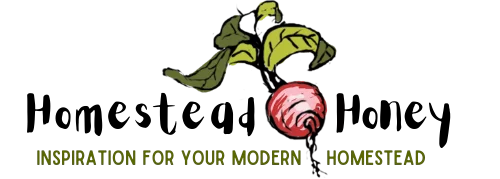
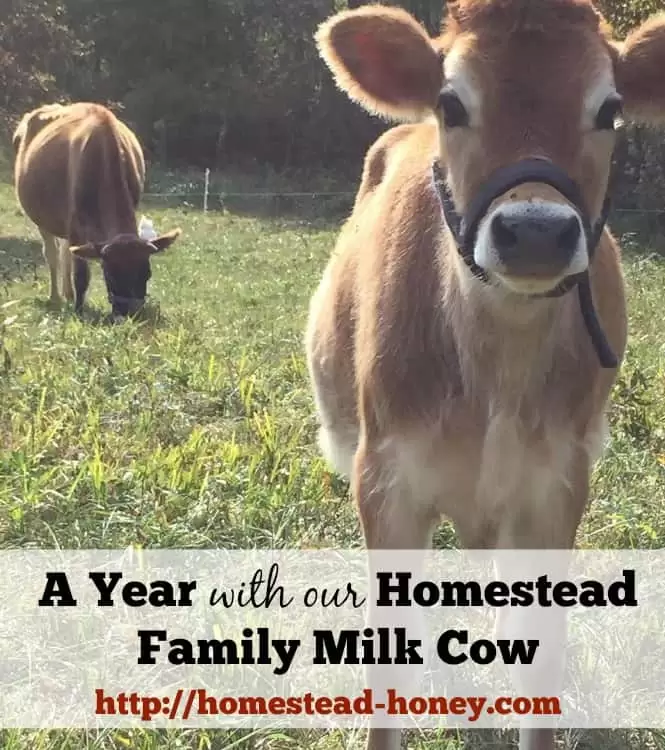
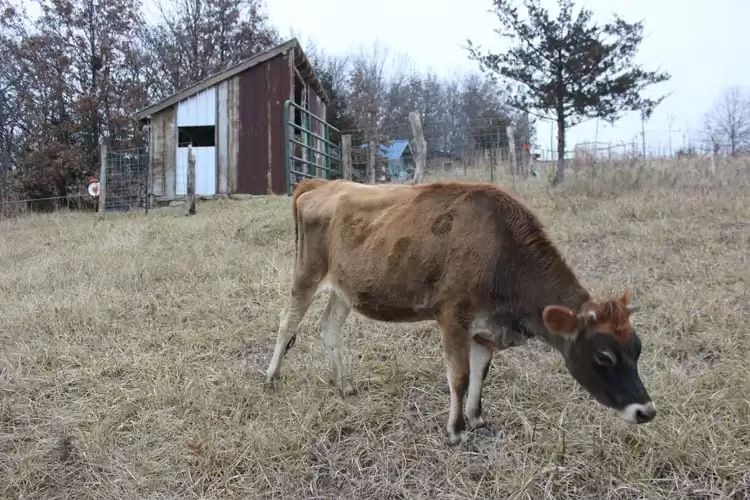
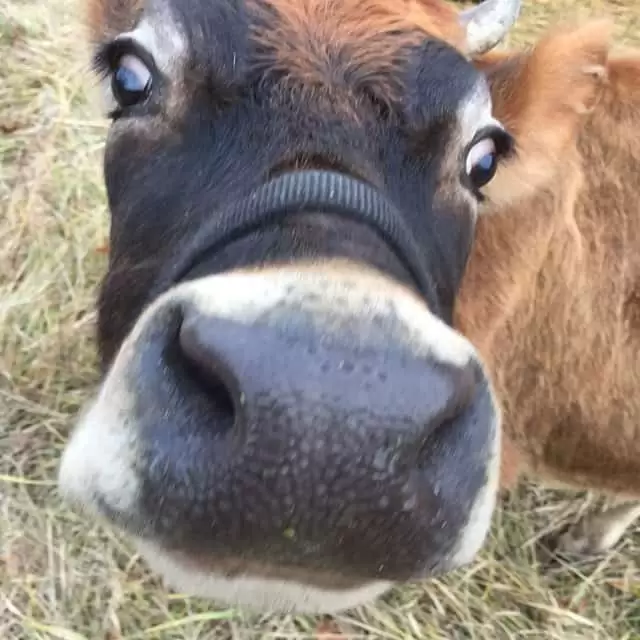
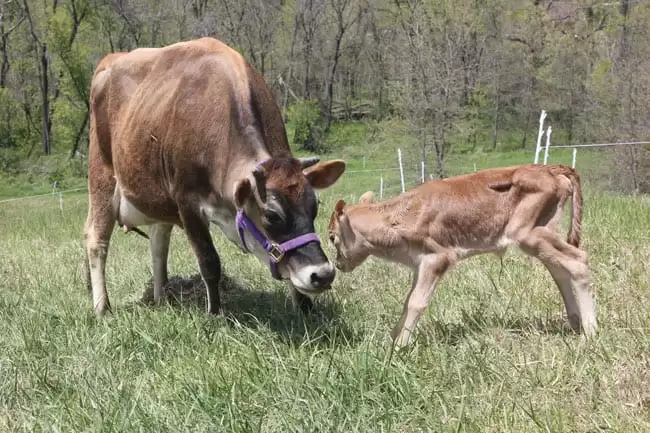
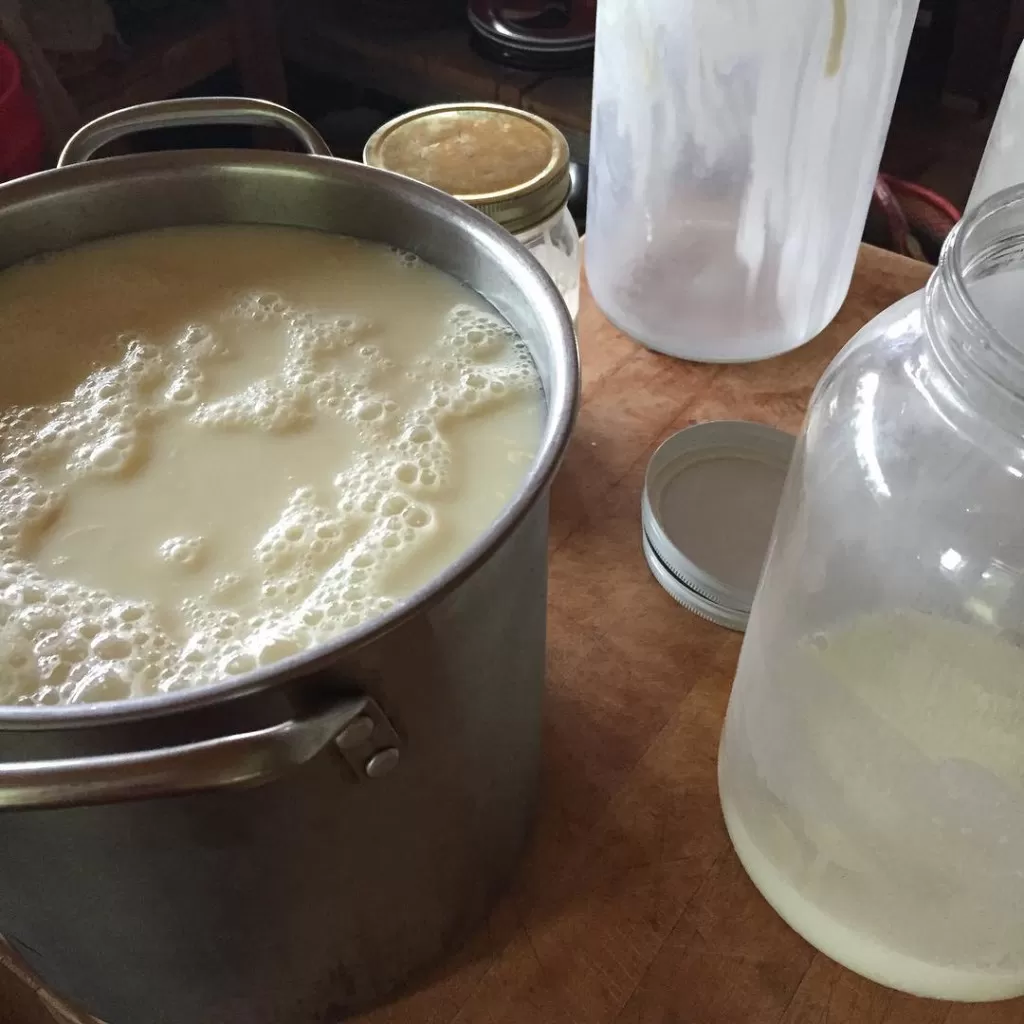
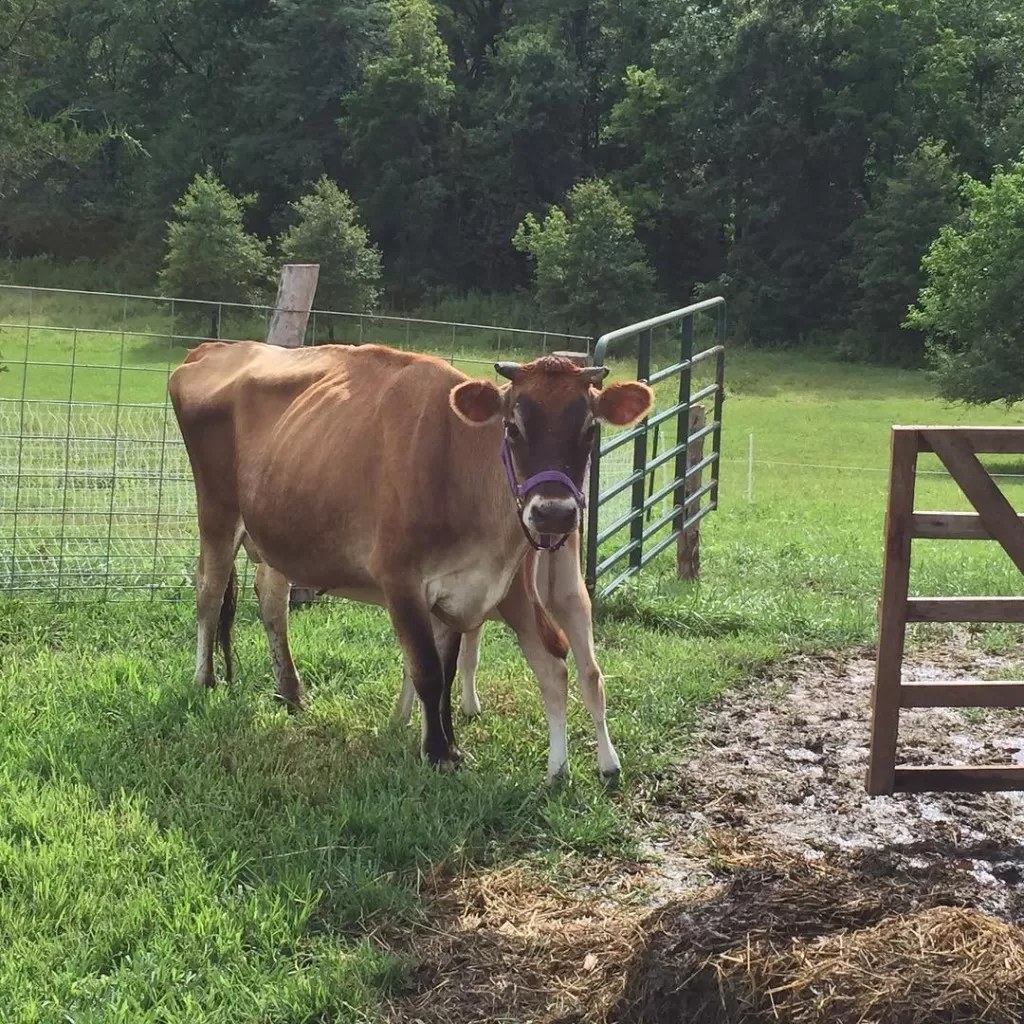
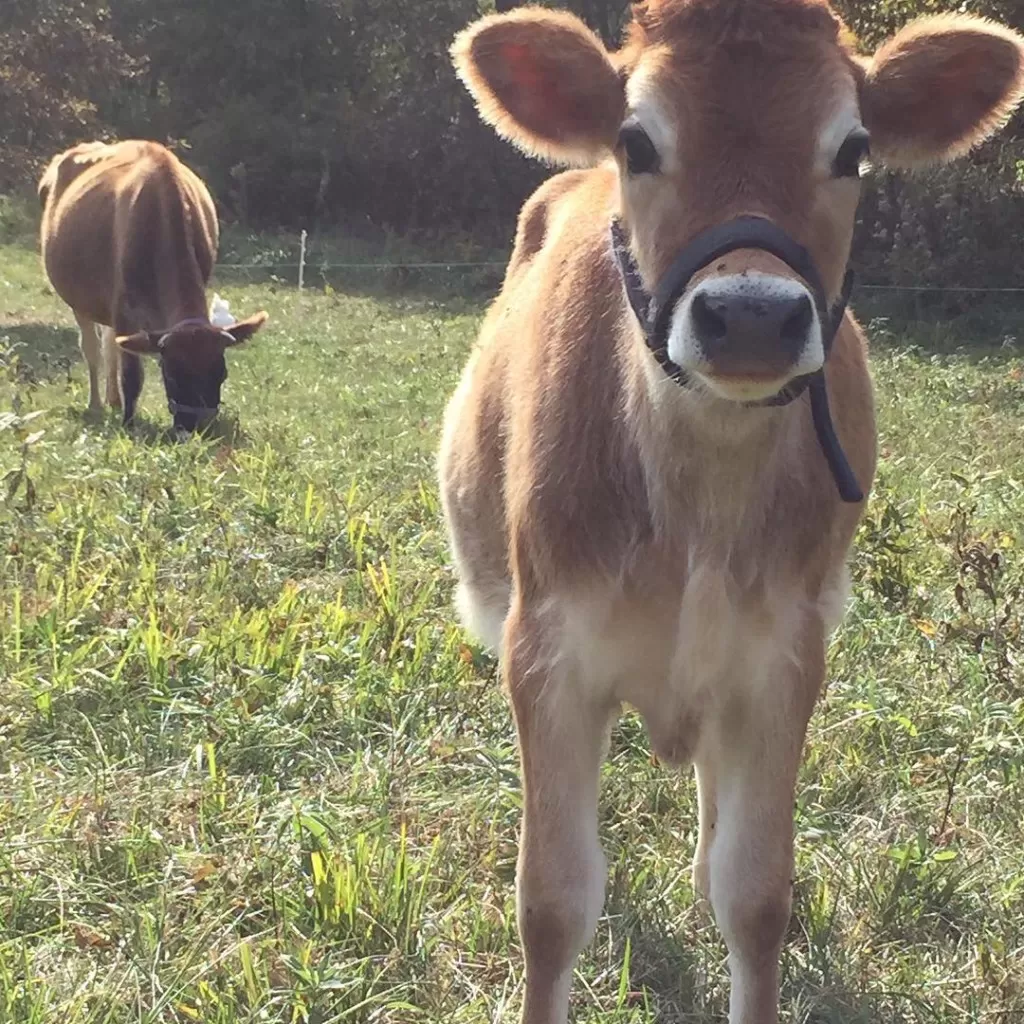


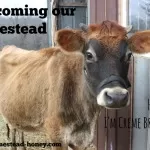


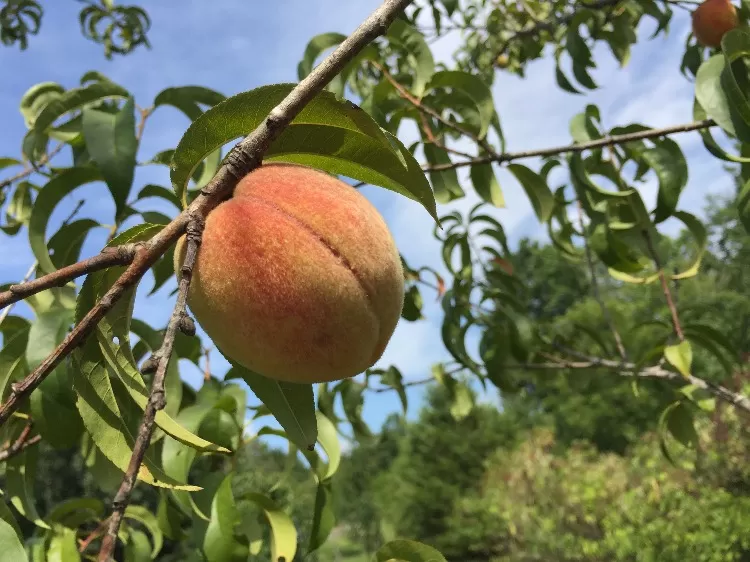


We recently bought a jersey heifer from auction and plan to breed her next spring with our Angus cows she is our family milk cow so I plan on milking her, but I also want to be able to leave her calf to free range nurse as well. Can you explain how you do this? How much do you milk for your consumption ? Thanks.
Hi Jolee,
We leave the calf with her dam until the calf is 6-9 months old. At first we let the calf drink what she/he likes and we milk in the morning and evening to take the rest. As the calf gets bigger, it will start to drink all the milk, so at that point we start separating the calf only at night. Then we milk in the morning, reunite the calf and mom, and let the calf nurse for the rest of the day. Milking once a day, we’re getting anywhere from a half gallon to a gallon and a half per milking (but our cow is not a high producer and we are not “pushing” her output with lots of grain).
What I like best about this approach is that if there is ever a time when we are not able to mill (an early morning commitment or a vacation), we simply leave the calf with the mom, and let her nurse day and night. Because the calf is old enough to drink her fill, and because we know our cow is not a high producer, it works very well.
Hi! Wondering if you could do a post about cow fencing/pastures? I can’t seem to find to much information about those things in the internet–how much pasture land do you have for your 1-2 cows? Thanks! 🙂 Love the blog! 🙂
Thanks Kayla. I can write something up about fencing. We are using a very simple system of single strand electric fencing with a solar charger. But it’s the details that really help with fencing questions! And our pasture is about 4 acres.
She is so beautiful!! And I adore her name. I would love to have a cow on our homestead one day. We just moved from the city so we are taking baby steps and will probably start with goats as our first farm animal. We have a very rambunctious Great Pyrenees puppy that we are trying to train and calm down so she can watch over our animals when we have them. She bounces all over the place and we don’t walk her, she walks us! I’m going to try what you did with Crème Brulee and dote on her, brush her lots, and just hang with her. It is hard though as we have snow and we also live in a tiny home (fifth wheel trailer) which she is just too high energy to be in right now. We’ll get it figured out, I’m sure 🙂
I bet when your Great Pyrenees has some animals to care for, she’ll take that job really seriously! I know some people let the dog live among the herd full-time – hard for you since you don’t have the animals yet, but I’m sure she’ll learn quickly, with your care! Good luck!
Like you, we used to have goats and were forced to give up goat-keeping because of a house move. I do miss the fabulous healthful cheese and yoghurt from our own pasture-fed animals. If we move again – and we plan to, in the near future, to a place where we would have wider opportunities to keep animals – we’ll stick with goats, because the rocky hilly terrain in our area is a far better fit for goats or sheep than for cows. I’ve never had much success in making goat cream and butter, though. The cream just didn’t float on top of the milk. I envy you for having a constant supply of homemade cream and butter! Still, any dairy animal is better than none, I say.
And I often feel longing for the flavorful cheese that we made with our goats’ milk!! I love both animals!
Thank you for your kind answer. Regarding cream, goat cream is different from cow cream I tried making goat cream and butter and the cream was thick and fine but with some goat flavour. Butter was tasty for some days but not longer. I gave it up and I buy cow cream and butter now. We can’t afford keeping a cow but we produce enough goat milk from 4-5 goats and we can modify the number if necessary. That’s what makes goats more affordable for us. I’m affraid of huge animals too, goats are small and easy to take in hands.
Yes, I agree about handling goats – so much easier than a cow! It took me quite some time to get used to the size and strength of our cow, and she’s a small Jersey!
Hi! I’d love for you to post about how you trained your heifer to become a mellow milk cow! We’re currently working with ours! 🙂 Thanks.
Kayla, I wish I could take credit, but Creme’s previous owner did all of the training. But I can tell you what we are doing with MayApple. The biggest thing is spending a lot of time with her. From the beginning, we loved and doted upon her, petting her, rubbing her legs and teats, etc. Unfortunately, she is skittish, so she really dislikes people approaching her. But once she comes to us, she loves being pet and brushed. We also have a halter on her, and have since she was a very young calf. It makes it easy to grab her when needed. She is used to being handled that way. When she gets a bit older, I will bring her into the milking parlor and begin training her to stand in the stanchion and be brushed, pet, teats touched, etc. I need to do a bit more work with her and leading. But I plan to do some over the winter.
We are getting close to obtaining our very first milk cow also! I am so excited, and can’t wail for all those firsts and learning-lessons you speak of.
I am curious though, now you have Creme and MayApple, and Creme is bred again. What are your plans for MayApple? And/or what about the new calf that will be born in May? Will you be keeping all of them? What about subsequent calves? Will they be put in the freezer? I know, a lot of questions, but I do not know anyone personally who has a milk cow, and have been wondering.
Thanks so much in advance.
JoAnn
Good questions. Herds tend to expand! I am breeding for A2/A2 genetics, so depending on what the gender and genetics of this spring calf are, MayApple will either stay with us, or get sold as a Family Milk Cow. If we have a male offspring this spring, i’d like to steer him and eat him. I don’t think we have the space for more than 3 cows, tops, and really, 2 cows would be better. But it’s really hard to imagine selling MayApple because we love her so much! But, financially, we are only going to be able to keep the cows if they pay for themselves, and the only way to do that is to either offset costs that we already have (dairy, meat), or to make money (selling them).
Have you checked Creme and Mayapples genetics? 🙂
Creme we did check the beta casein. She’s A1/A2. MayApple we have not checked yet, but both of her parents were A1/A2, so she has a 25% chance of being A2/A2. Creme was bred to a A2/A2 bull this year, so the off-spring has a good chance of being A2/A2.
They are so lovely! I bet you have a very strong connection with them, I hear cows are really intelligent and social animals. Perhaps getting up early each morning might become a drag but than again: when you are greeted by these sweet and beautiful animals that must make up for that in a second! I like reading about these things, it makes me want a homestead of my own. Maybe some day, although here in the Netherlands the climate is probably less ideal 😉 Kind regards, Marjolein
Yes, they are very smart and sweet! (I have to admit that I don’t get up early! They are very patient waiting for me to milk). I can imagine that cows would make anyone want a homestead!!
It’s wonderful to read of the life Creme Brûlée has on your homestead, particularly that you leave her calf to nurse on demand. That’s what we do too. In his nearly 30 years of practice, our vet has never seen a calf left with the mother past a few hours or a few days. He marvels at our large, healthy calves.
Here’s what life is life for cattle on our little place. https://bitofearthfarm.wordpress.com/2013/03/21/isabelles-life-gently-raising-dairy-cows/
And here’s an excellent source of information from homesteaders and small farmers — the Family Cow forum: http://familycow.proboards.com/board/19
Thank you, Laura. I love your article about Isabelle. What a lucky cow! I am part of the Keeping a Family Cow group on Facebook, and love the book as well. I’ve yet to join the forum, mostly because I fear that I’ll get sucked into yet another online distraction!!
(By the way, I’ve been really wanting to read your book! Homeschooling and homesteading are really a perfect mix)
Hello, being myself a goat keeper, could you please tell me what made you give up the goats and start a new life with a cow? I was always curious to know how different these 2 animals feel. Are goats not so profitable or did you just consider a single animal more productive than several goats? I would appreciate your answer very much because I honestly want to know if the benefits of goat milk are over the advantages of cow milk or not or maybe it depends ?Quality vs quantity what do you think?
Hi Alex,
We didn’t intentionally give up goats, but when we moved to Missouri, we came to a piece of raw land. We didn’t have a way to bring them to our land at that time, so we found homes for them in OR. It became clear that our land here in MO was better suited for cows, and the fencing requirements for cows (single strand electric wire) are much easier than goats!
I do miss our goats terribly. They are wonderful animals. But there is something about cream…